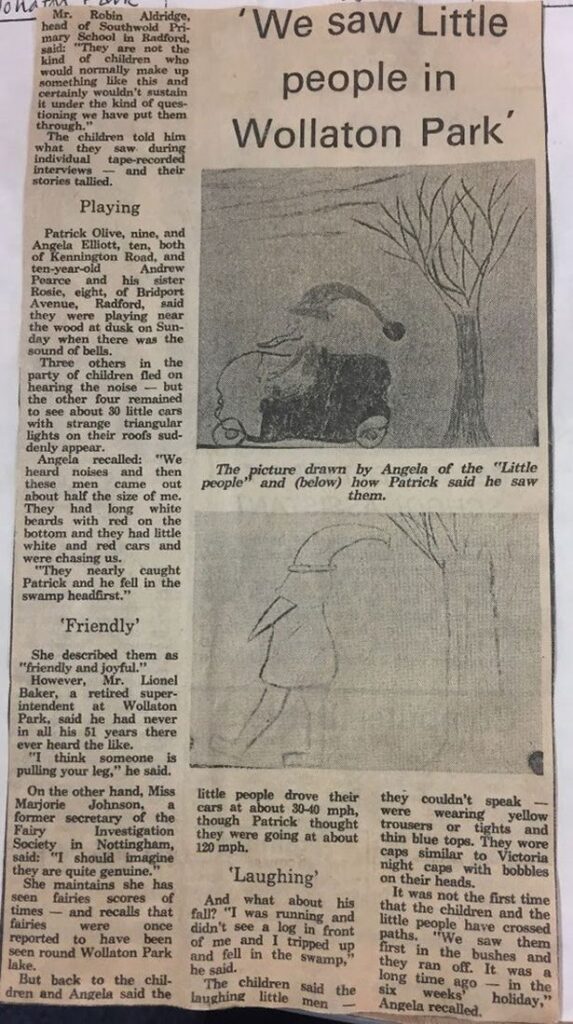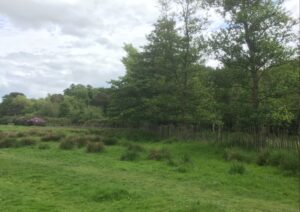Dark Thoughts on the Wollaton Gnomes January 31, 2022
Author: Beach Combing | in : Contemporary , trackbackIntroduction
The Wollaton Gnomes was a classic anomalous encounter. 23 September 1979, a half dozen primary school children went for an evening walk in Wollaton Park in Nottingham. A number of these children then saw thirty small cars each with a gnome driver and passenger. The encounter lasted, according to the children, about fifteen minutes, as the gnome cars chased them around the park. The kids eventually escaped out into the surrounding streets where the gnomes declined to follow them.
I’ve recently spent a lot of time on the Wollaton encounter. I’ve presented a podcast looking at the case with Chris Woodyard and I’ve also edited a book (click here for US) with the original sources and ten essays by various folklorists, fairyists and Forteans. It is a fascinating, fascinating incident not least because it is so well documented. We have an interview transcript of the children recorded less than 48 hours after the sighting (and two pictures drawn by the children including the one above); newspaper reports with interviews with parents, teachers and children; extra fairy and gnome sightings in the area (some included below); and an investigation by Fairy Investigation Society stalwart Marjorie Johnson. All of these are brought together in the book and many are commented upon in the podcast.
I’ve been interested in this case for years. But in putting together the podcast and the volume I’ve learnt three important things: first, the encounter was far messier than most accounts suggest; second, the encounter did not take place in, let us say, ideal light conditions; and third, this was not the only time that children met gnomes in the park.
Encounter
Let’s start with the encounter itself. There were six to eight kids, not as is often said three or four: however, the reference to the three or four has a kind of logic as I’ll now explain. The kids met up at about eight o’clock. They wandered about a mile from their homes and visited a school, probably the Margaret Glen Bott Secondary Modern. They were, at 8.00 in the evening, trespassing. They then went into Wollaton park by one of the northern entrances: Frank Earp points to the Harrow Road entrance in the book. That park, too, was officially closed. I’m not being at all critical here: I’m all for free-range kids having fun on other people’s property. But we should imagine that the evening had a whiff of illicit adventure to it!
At this point the children seem to have wandered across one of the lush fields in the parks and they came to a bit of fenced woodland. This area was known by local kids as ‘the Swamps’. I found one local who remembered losing shoes there in his childhood! The park authorities allowed no one into this boggy area, hence the fence. But some of the children decided to go through a hole into the marshy woodland beyond. The evening was about to get more interesting. According to the transcript four went in (Andrew, Patrick, Angela and Rosie): these were, note, the older members of the group.
Once this ‘older’ group was in the Swamps, the encounter began. First, the children saw movement in the tree tops. Then the gnome cars appeared and began to chase them. The two boys fell into a marsh. In one account the gnomes dropped on their backs, in another they drove them into the mud. The four, in any case, beat a swift retreat back into the field.
We then move into the next phase of the encounter. The four older kids are reunited with the younger kids: two of the four, remember, caked in mud. The older kids tell the younger children what they have seen, but the younger kids are having nothing of it. However, at that point the gnome cars emerge from out of the Swamp and come after all the kids. The children run for the exit – we are not sure which one. The gnomes desist and do not chase them into the streets.
Light
I’ve struggled here to reconstruct the sequence of events. But the second issue to bear in mind is the quality of light that evening. When, over the years, I’ve imagined this encounter I’ve thought of the children coming across the gnomes at twilight. I had probably picked up on some of the comments in the sources to the light and particularly to street lights. I realise now that this is far more important than I had originally understood.
Sunset on 23 September was at 7.02 pm. Dusk was at 7.36 and by 8.00 pm when the kids met it was entirely dark (I take these times from Dan Green’s essay in the book). There was a weak crescent moon in the sky and it had been a rainy day. We can assume, I think, that the sky was at least partly overcast. When the children came into the park then it was already full night. As they traipsed across the field it was black. There was some light from the nearby houses and from the distant street lights.
They then arrived at the fence of the swamps. There must have been some secondary light there for them to find their way through the fence into the Swamps. Chris Woodyard joked on the podcast that the kids had double dared themselves to go into the Swamps. At 8, 9 or 10 I’m not sure I would have had the courage. It must have been a good deal darker within the Swamps than in the field. There were trees (still with leaves in late September?). There was undergrowth: this was a wild, unmanaged bit of the wood.
Three of the children were interviewed about what they saw in the Swamps. The descriptions were remarkably detailed. They talked of the colour of the beards and clothes (trousers with patches). They talked of the hats of the gnomes and also of the colour of their cars. They stated confidently that there were thirty cars with sixty gnomes: each of the three kids repeated these exact numbers. It would have been absolutely impossible to see these things under normal night-time conditions.
Both the headmaster who asked the questions in the transcript, Robin Aldridge, and Marjorie Johnson in her report recognised that the lack of light was a real problem. The headmaster asked the children individually how they had seen things given the lack of light. Patrick talked of the gnomes glowing in the dark (‘They showed up’); Andrew claimed that there was a light in the trees (‘we seen a light in the trees hanging’). Marjorie Johnson, who believed the account, insisted that fairies have their own light and can be seen in the dark. Almost all derivative accounts, including contemporary newspapers, just skimmed over these awkward details.
Local Gnome Folklore
Frank Earp in the book gives some reasons for thinking that the episode may have been invented: I’m going to keep an open mind on that, at least, for now. But I do think of the encounter in a different way from when I started putting the book and the podcast together. This, for what it is worth, is my reconstruction.
Here were half a dozen kids having fun in the dark. They passed into the park brimming with the spirit of adventure and four of them, the older and braver, decided to penetrate the Swamps. There something happened and the children had their encounter. Certainly, two of them got in an almighty and muddy mess. I don’t know what took place in the Swamps. This is the real mystery.
The older and younger children then met up again outside the Swamps and ran for the exit, the whole group infected by the exhilaration of the older kids. I’m less impressed by claims that the children saw gnomes in the second phase of the encounter. My impression is that this really could have been group ‘hysteria’ (for want of a better word): younger children caught between enjoyment and fear of their night-time walk, glimpsing things in the bushes as they ran for the streets.
What happened in the Swamps? There are, to my mind, three possibilities that I throw out here to be taken up or rejected according to the reader’s instincts. First, the four children went into the swamp and two of them got dirty. The gnomes became an excuse to explain what happened, one that was created on the hoof and then elaborated as they chased with the younger kids for the exits. Perhaps ‘playing’ the younger kids, one of whom was crying, was part of the fun?
Second, the four were spooked by some stimulus and in the dark and after being muddied this stimulus (e.g. a startled animal) inspired the sense of an encounter. I can well imagine, say, an escaping fox being understood to be a little man in a car: night-time ‘visions’ are full of such inconceivable misunderstandings. The children filled out the gaps talking to each other and came up with the thirty gnomes in cars. Witness accounts can initially spiral up before being nailed down in repeated tellings.
Third, the four met a score or two score little people driving in Noddy-style cars. The little people and their vehicles glowed in the dark and chased the children.
Which is the correct answer? I don’t know. However, there is another discovery that I made while preparing the book which seems important to me. It is clear that Wollaton Park was a place with a reputation for fairy encounters: several are associated with the grounds (about ten relevant encounters are included in the book). It also emerges that the children had claimed to see (again in the dark) gnomes in the park in the summer holidays, two or three months before. Finally, one of the children’s older siblings saw more gnomes in cars the day after their sighting…
Reading between the lines it appears that the half dozen Wollaton kids (and perhaps local kids generally) had a private folklore about the park and some mysterious beings that lived there. This could be taken as useful proof that the Wollaton children really did see gnomes on that Sunday night in 1979. Or, alternatively, this could be the context that we need to explain how a dunking in the mud in the dark,* perhaps associated with some minor stimulus, became an encounter with a flotilla of gnome cars.
The mystery remains: the conversation will continue.
* My guess would be that the two children falling in the mud was central to the experience. All three kids put it in the heart of their account.
Paul Garner, the swamps.







